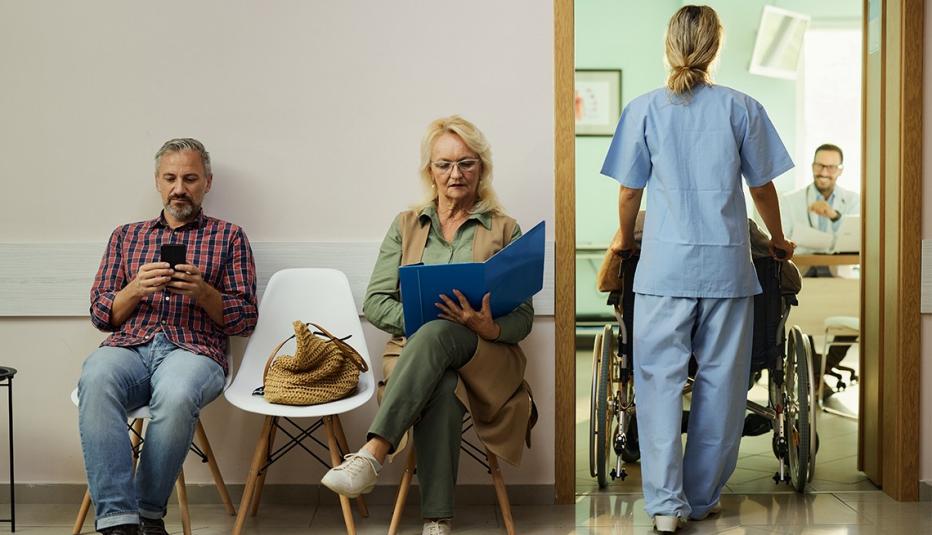AARP Hearing Center
Health care affordability, rising health insurance costs, and a lack of confidence in affording unexpected medical bills are significant concerns for adults ages 40 to 64. A new AARP Research study found that affording health care costs was an issue for a substantial number of adults within this age group.


In fact, three in 10 were more likely to forgo taking a medication because of its cost within the last 12 months. That percentage closely mirrored those who experienced an adverse medical event during that time.
Key Findings
Affording heath care was a leading concern among adults 40 to 49, with 8% more likely to borrow money from family and friends to cover medical expenses — 2% more than those 60 to 64. The younger group also were more likely to have received an unexpected medical bill.
Surprise medical bills and adverse medical events prove to be all-too-common occurrences. Respondents identified experiencing the following situations within the last 12 months:
- Received medical bills they could not afford (14%).
- Had trouble paying bills because of medical expenses (9%).
- Used all or most of their savings to pay medical expenses (7%).
- Made trade-offs between buying medicine and other necessities like food (6%).
- Borrowed money from family and friends to pay for medical expenses (5%).
- Considered giving up insurance coverage because it was too expensive (5%).
- Dropped insurance coverage because it was too expensive (3%).
- Filed personal bankruptcy in part or in full due to medical expenses (1%).
Lacking Confidence
Those ages 40–64 had varying levels of confidence in being able to afford a $1,000 unexpected medical bill within 30 days, with one-fifth more likely unable to afford it. Meanwhile, the 40–49 group were more likely to be not very or not at all confident in having the ability to pay that amount within that timeframe.
This confidence varied significantly by gender, with men (35%) being more optimistic (extremely or very likely) about having the means to pay an unexpected medical bill or, if needed, pay for care for a financially dependent family member who becomes seriously ill. Meanwhile, women (42%) find affording a surprise medical bill to be more problematic, reporting that they are not very or not at all confident they could cover the bill.
All age groups credit the COVID-19 pandemic for making it harder to afford health care for their families, with those ages 40–49 finding it the most challenging.
Health Insurance Coverage
Employer-based health insurance coverage is the most common, held by more than four in 10 adults ages 40–64, with about one in seven having coverage through their spouse or partners current employer or through Medicaid.
Among those with health insurance, dissatisfaction is highest with their annual deductibles (30%) and monthly premiums (26%). Adults ages 40–49 are more likely than those ages 60 and older to say they are extremely or very dissatisfied with their annual deductibles (34% vs. 24%), their monthly premiums (28% vs. 20%), and their overall coverage (20% vs. 11%).
One-third of adults 40–64 who reported not having health insurance said they did not think they needed it, while others noted high monthly premiums (27%) as well as high deductibles (14%) and co-pays (10%). Additionally, three-quarters of those without health insurance report they have been without coverage for two years or more, with the cost of insurance premiums cited by half of them as the top reason.
Health Insurance Affordability
One-fifth of adults 40–64 consider a $50 a month individual health insurance premium as unaffordable. Here, too, women are more likely than men to find a $50 premium unaffordable (23% vs. 16%).
Of the study group, 43% of respondents identified reducing the price of monthly health insurance premiums as one of the most important health care affordability issues for policymakers to address. Another 31% want reduced out-of-pocket costs, such as deductibles and copays, while 16% cited reduced prescription costs, and 8% want access to more doctors and specialists.
Again, in terms of gender differences, women are more likely than men to say that reducing out-of-pocket costs is most important, while men are more likely to cite access to more doctors or specialists.
Among those saying the pandemic has made it harder to afford health care, those 40–49 (23%) said it’s harder for them, followed by those 50–59 (19%), and then those 60–64 (16%). Men (19%) were slightly more optimistic than women (20%).
Methodology
The nationally representative online and telephone survey of U.S. adults ages 40–64 via NORC’s Foresight 50+ panel was conducted for AARP from May 24–June 9, 2022. Data are weighted to benchmarks from the November 2020 Current Population Survey Voter Supplement and the 2019 American Community Survey by gender, age, education, race/ethnicity, and census division.





























































